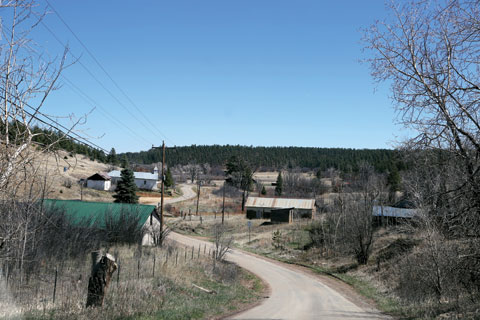 |
||||||||||||
|
May/June 2015
BY RICHARD CURREY “Up here in northern New Mexico Willie Salas was telling me about the tradition of military service and patriotic pride that marks his home town of Las Vegas, N.M., and the surrounding villages and hamlets scattered across the thinly populated counties north of Santa Fe. Salas served with the 1st Marine Division in Vietnam. “I was a groundpounder,” he said. His brother Paul, who also was born and raised and still lives in Las Vegas, was a Marine scout-sniper in Vietnam. “We’re just two guys who did our part,” Willie Salas said. “Many more went out of this little town to serve. The tradition here in New Mexico is like the man this building is named for.” Salas was referring to the fact that we were sitting in the Miguel Encinias Veterans Center, home to the regional office of the New Mexico State Department of Veterans’ Services and the informal HQ for VVA Chapter 1063. Encinias, another Las Vegas native who is now 92, is an exemplar of the tradition of military service one sees not just in northern New Mexico but throughout the state. But his life also speaks to the Hispanic struggle to overcome discrimination, demonstrating how the effort to achieve basic equality can raise an individual to rare levels of courage and sacrifice. Encinias recorded an oral history for the University of Texas several years ago, recalling that young Hispanic men in New Mexico enlisted in great numbers after Pearl Harbor. One thing he noticed was that “the enlisted men were predominantly Hispanic. The only Anglos in our company were the officers.” Encinias’s recollections underscore the impact that ethnicity has had in New Mexico’s history. “I wanted to prove that, being a minority, I was as good as everybody,” Encinias said. “I was trying to prove something to myself and to others that knew me.” Encinias achieved that goal many times over: He became a fighter pilot in the Army Air Corps; flew forty combat missions over North Africa and Sicily, where he shot down three enemy aircraft before his own plane was downed; and spent the last fifteen months of the war in a German POW camp. A few years later he was flying combat missions over Korea, where he was again shot down and rescued behind enemy lines. He later flew sixty combat missions over Vietnam before retiring from the Air Force with three Distinguished Flying Crosses and two Purple Hearts. Encinias’s original pledge to “prove something to myself and to others that knew me” is a vow that has continued to inspire and motivate young Hispanic New Mexicans, with military service often serving as a conduit for the desire both to serve and to demonstrate that one can be “as good as everybody.”
Encinias’s namesake building is the old Las Vegas Armory, originally built in 1907, later damaged by fire and rebuilt to serve as the state Veterans’ Services regional headquarters. When one steps through the building’s front doors, the first thing to meet the eye is a wall covered with photos of local men who died in Vietnam, a display maintained by Chapter 1063. Or “the 1063,” as Orlando Ortiz affectionately refers to his chapter. “The 1063 is family,” Ortiz said. “You have your wife, brothers and sisters, children, and that’s very important, of course. But we have another family, just as important, and that’s our brothers in arms. These guys are my family, too.”
Ortiz enlisted in 1967 and served six years. After he was discharged he came home to New Mexico, he said. “Coming back wasn’t something I had to think about.” Ortiz’s feelings are representative of the continuing vitality and significance of family in New Mexico, a region where the large extended family—in decline in many parts of the country—continues to enjoy an almost sacred tradition and to be a norm rather than a rarity. Karen Abeyta is the dynamic veterans service officer based in the Encinias Center. Her “range,” as she calls it, is a vast piece of the state that includes Las Vegas and San Miguel County and reaches across the breadth of north-central New Mexico. Abeyta hails from an extended family with deep local roots and a military tradition—her grandfather was a World War II Army vet, her godfather is a Vietnam veteran who holds a Purple Heart, and her cousin was killed in action in Kuwait. She was educated in the Las Vegas schools before doing a stint in the Navy. Following her enlistment, she—like Orlando Ortiz and Willie Salas—came home to build her life in Las Vegas.
But if the focal point of family tradition is a critical element in the lives of the proud Hispanics of New Mexico living in one of the most beautiful places on the planet, another factor leverages against this seemingly charmed combination of culture and beauty: poverty. New Mexico is one of the poorest states in the nation. Making a living in the state is not, and has never been, an easy matter, particularly in the rural areas far removed from Santa Fe, Albuquerque, and Las Cruces. The Spanish have been in New Mexico for more than four hundred years. They came first as invaders and conquerors of the indigenous Pueblo Indians. In time the hallmarks of Spanish culture joined those of the Indians and the new Anglo pioneers arriving from the East to create a unique commingling of religion, social values, folklore, music, and food. But as the imprint of New Mexico’s cultural life blossomed, the mountains, dry-cut deserts, and narrow, rutted roads formed a natural barrier to travel, particularly through the arroyos and desert plateaus north of Santa Fe. The larger effect of this topography was isolation, and New Mexico remained an economic backwater. This predicament still tends to hold true, at least in the rural communities and fading small towns of northern New Mexico where Hispanic families have struggled for generations. In San Miguel County, per capita income hovers at $18,000 a year. Nearly 30 percent of the population lives at or below the poverty line. New Mexico’s Hispanics confront these challenges with religious faith, the strength derived from their deeply rooted extended families, and firm and long-standing social values. “You might say we took our stand,” said Salas. “We looked around at this beautiful place God gave us and we made our homes and raised our children and built a way of life. There are things about life here that are hard, things that could be better. But this is what has been given to us, and we try to honor that and do right by it.” This is a way of life that creates and supports a durable sense of cultural identity and the family-centered beliefs that keep people at home, living happily among grandparents, parents, children, and cousins and making a living as best they can. If individuals move away for any length of time—with military service being one principal reason—they come back. “We tend to always come back,” Salas said. “I’ve been to Vietnam, I’ve been all over the world, but there was never any doubt that in the end I’d be coming back to New Mexico, to Las Vegas. This is my barrio. This is where I live and my people live.”
When Willie Salas came home from Vietnam in 1967, he was a seasoned Marine who had traveled the familiar road from hopeful recruit to demoralized veteran. “ Like Salas, Peter Garduno is an former Marine who is a retired teacher. Now the Chapter 1036 president, Garduno is an accomplished artist who created a Vietnam War mural in the Encinias Center. The mural is a kind of overview of the war, composed with multiple angles and perspectives, capturing much of the Vietnam War’s iconography and imagery in one extended piece. It is a unique work that creates the effect of simultaneously seeing from the air, from the ground, and from various vantage points above rice paddies and jungles. “I tried to pull together as many views of the war as I could. The mural tells as many stories as possible within the borders of a single painting,” Garduno said. His portrait of the Vietnam War brings a singular quality to the Encinias Center, an unexpected moment as one climbs the stairs to Karen Abeyta’s office. “We are very proud of Peter’s mural,” Abeyta said. “It helps us remember and honor these vets. And it reminds us of how important our Vietnam vets are.”
Chapter 1063’s color guard is perhaps the most visible symbol of not only the chapter but of Vietnam veterans in Las Vegas. The color guard has participated in many parades and presentations of colors. “Maybe the most touching, at least for me, is participating in the funerals of vets,” said Garduno, a color guard member. “We’ve also done several funerals at the national veterans cemetery in Santa Fe. These are very moving events.” (See the July/August 2014 issue of The VVA Veteran.)
Meanwhile, both Karen Abeyta and Peter Garduno sit on Las Vegas’s Veterans Advisory Council, a group formed just more than a year ago by Mayor Alfonso Ortiz, Jr. “We have representation by vets of different generations,” Abeyta said. “We look at what our community can do, or continue doing, to assist our veterans. There are a lot of new ideas coming forward, too.” Abeyta said that the mayor’s council, her work as a state veterans service officer, and the efforts of Chapter 1063 all point to how “we feel about our vets here in northern New Mexico. We try not to just toss around words like ‘family’ or ‘patriotism.’ We work to keep those ideas alive.” Abeyta said that the mayor’s advisory council is another way to exercise the community’s values on a day-to-day basis and in real-life terms. Willie Salas and I were talking about how the war ended for some, the pure shock of actually knowing it was over and you were headed home. Salas was quiet for a moment. “Thing is,” he said, “you come home, but you’re not home. You say we survived, but did we? In a way, none of us survived. We’re alive, yes, but for many guys, and certainly many of the guys who came home to Vegas and San Miguel County, ‘survival’ is a relative term. We all saw so much, went through so much. It was rough. It still is. “But you know,” Salas said, “out of this area, this little town, the barrio I grew up in here, we sent forty-seven men to Vietnam. Forty-seven men! Nobody can say we didn’t pull our weight.” Downstairs, in the front lobby of the building, the wall of portraits greets visitors. Local men killed in action in Vietnam. Thirty-four faces gaze back at me from the wall, talk to me across the years from official boot camp portraits, sit shirtless in front of hooches and smile at the camera; or pose with parents, sisters, and brothers: all these young men who did not come home to Las Vegas and are clearly mourned still. “We wanted to recognize these boys,” Garduno said, “to honor their sacrifice. Every time we step into this building, we see them here and are able to give our own little salute. It might be just a private thought, or something you whisper under your breath, but we can say: ‘Saludos, brothers. You gave all—and we remember.’”
|
||||||||||||
|
|
||||||||||||
|
||||||||||||
8719 Colesville Road, Suite 100, Silver Spring. MD 20910 | www.vva.org | contact us |
||||||||||||













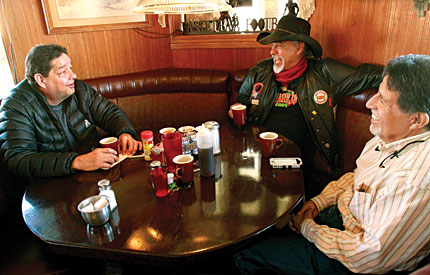
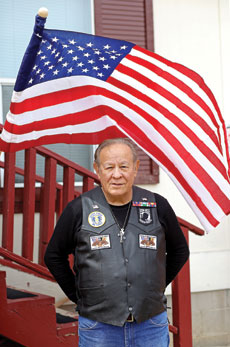 Ortiz is an Air Force veteran who was an aircraft mechanic stationed in Alaska with the Tiger Combat Support Group, a SAC unit. “I didn’t serve in-country—I serviced the aircraft that dropped the bombs,” he said. “So, in a way, we were as much a part of the war and the damage done as somebody pulling a trigger on the ground.” Ortiz is from Rowe, “just down the road from Vegas. I had a wonderful family, a wonderful childhood. It was great to grow up here in northern New Mexico.”
Ortiz is an Air Force veteran who was an aircraft mechanic stationed in Alaska with the Tiger Combat Support Group, a SAC unit. “I didn’t serve in-country—I serviced the aircraft that dropped the bombs,” he said. “So, in a way, we were as much a part of the war and the damage done as somebody pulling a trigger on the ground.” Ortiz is from Rowe, “just down the road from Vegas. I had a wonderful family, a wonderful childhood. It was great to grow up here in northern New Mexico.”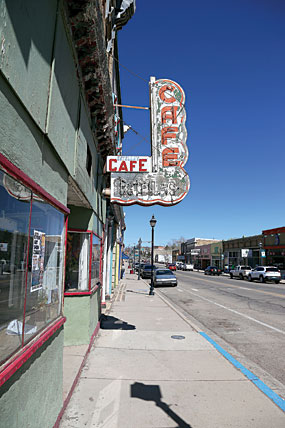 New Mexico’s nickname, the “Land of Enchantment,” was first used on its license plates in 1941. It quickly became the state’s brand, its tag line, an identifier used in all manner of official documents and promotional literature alike. But the phrase goes beyond simply being a nickname. New Mexico is indeed a remarkable place, a kind of magical terrain of buttes, mesas, alluvial washes, and vast dun-colored plateaus flecked by thousands of wind-stunted juniper trees. Snow-capped peaks sawtooth the horizon. The sky is cloudless, infinite, the pure blue of a ceramic glaze. Even for the more practical-minded among us, the effect tends to the mystical. It is, indeed, enchanting.
New Mexico’s nickname, the “Land of Enchantment,” was first used on its license plates in 1941. It quickly became the state’s brand, its tag line, an identifier used in all manner of official documents and promotional literature alike. But the phrase goes beyond simply being a nickname. New Mexico is indeed a remarkable place, a kind of magical terrain of buttes, mesas, alluvial washes, and vast dun-colored plateaus flecked by thousands of wind-stunted juniper trees. Snow-capped peaks sawtooth the horizon. The sky is cloudless, infinite, the pure blue of a ceramic glaze. Even for the more practical-minded among us, the effect tends to the mystical. It is, indeed, enchanting.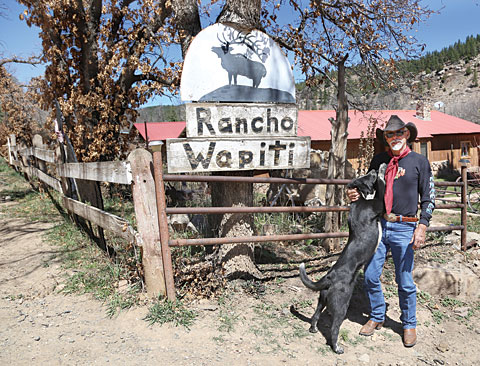
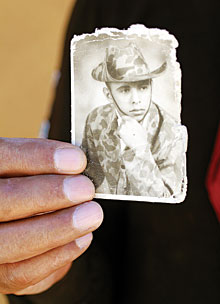 By the time I left the Marines, I was angry, disappointed, sad. Vegas is a good place to come home to after you’ve been through something like Vietnam and were feeling the way I was,” he said. “It wasn’t like the rest of the country, where Vietnam vets had to keep their service a secret. Here we still had recognition and respect. It’s the way of things here. We might’ve hated the war, but the veterans were our own boys, our native sons. So I came home, I went to school here in Vegas at Highlands University, got my degrees, and taught school for thirty-two years, at all levels.”
By the time I left the Marines, I was angry, disappointed, sad. Vegas is a good place to come home to after you’ve been through something like Vietnam and were feeling the way I was,” he said. “It wasn’t like the rest of the country, where Vietnam vets had to keep their service a secret. Here we still had recognition and respect. It’s the way of things here. We might’ve hated the war, but the veterans were our own boys, our native sons. So I came home, I went to school here in Vegas at Highlands University, got my degrees, and taught school for thirty-two years, at all levels.”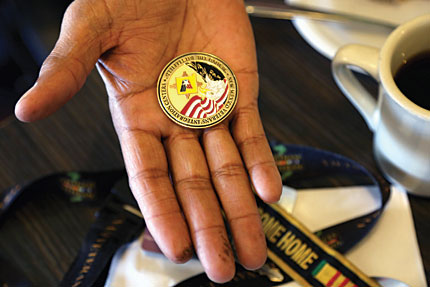 Even though she knows that the Vietnam era is beginning to feel like a long time ago, Abeyta said that Chapter 1063 is not the sort of group that sits around mourning a bygone time. “The chapter is a wonderful group of men,” she said. “They are so positive. It rubs off on others. They do a lot for Las Vegas and for vets in surrounding communities.”
Even though she knows that the Vietnam era is beginning to feel like a long time ago, Abeyta said that Chapter 1063 is not the sort of group that sits around mourning a bygone time. “The chapter is a wonderful group of men,” she said. “They are so positive. It rubs off on others. They do a lot for Las Vegas and for vets in surrounding communities.”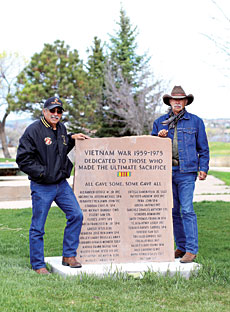 The chapter has been proactively meeting community needs, including work with Ride to Pride, an equine therapy nonprofit aimed at helping vets with PTSD and related issues, and a recent stand-down in Las Vegas that benefited more than one hundred homeless veterans. The chapter also sponsors an annual $500 scholarship award to a child or grandchild of a Vietnam veteran, based on student essays about the Vietnam era.
The chapter has been proactively meeting community needs, including work with Ride to Pride, an equine therapy nonprofit aimed at helping vets with PTSD and related issues, and a recent stand-down in Las Vegas that benefited more than one hundred homeless veterans. The chapter also sponsors an annual $500 scholarship award to a child or grandchild of a Vietnam veteran, based on student essays about the Vietnam era.